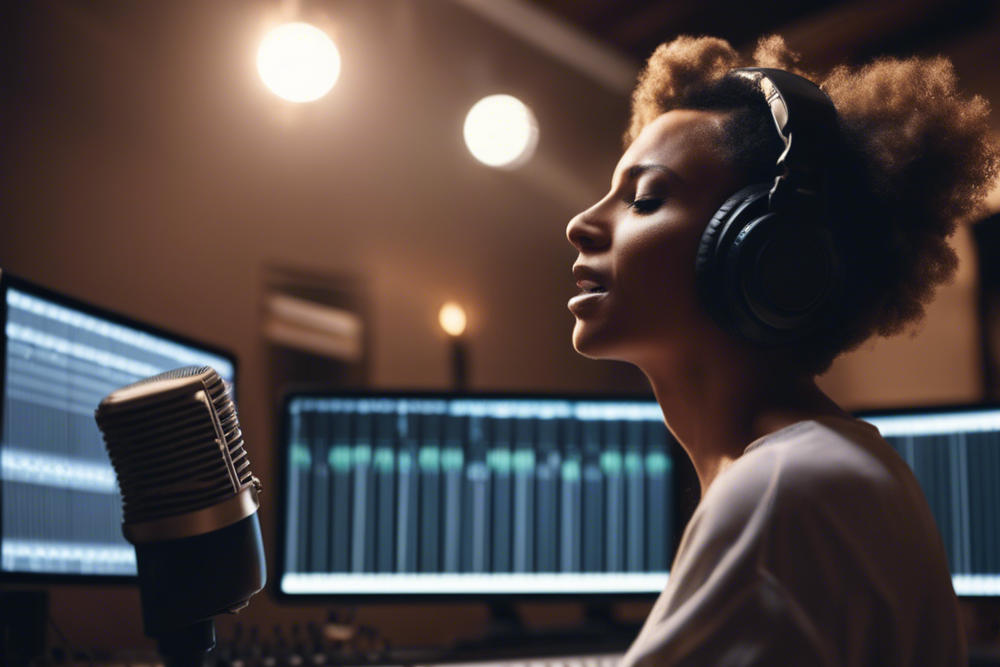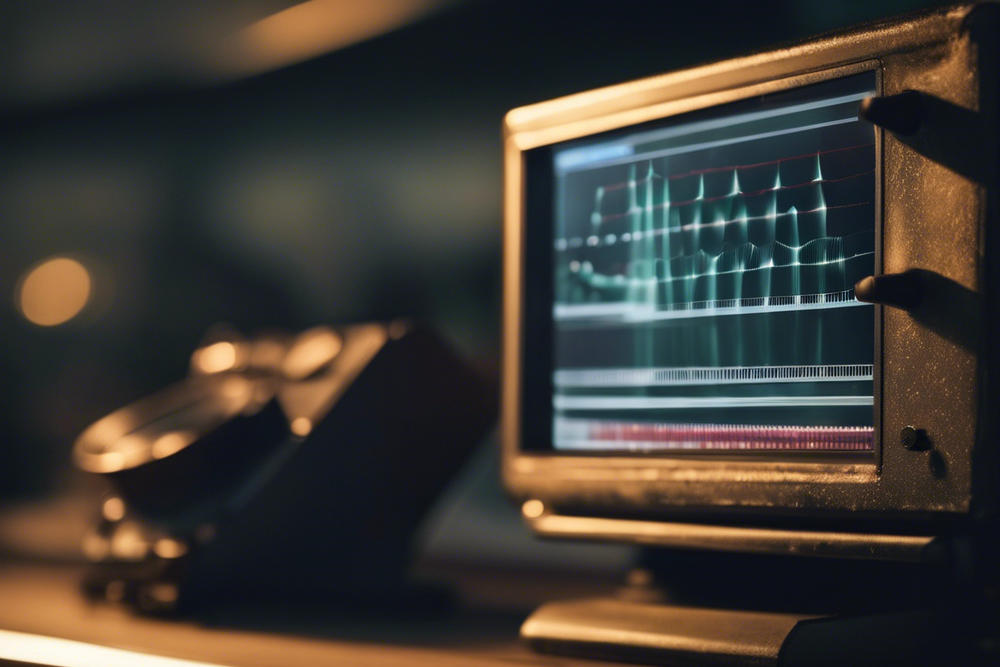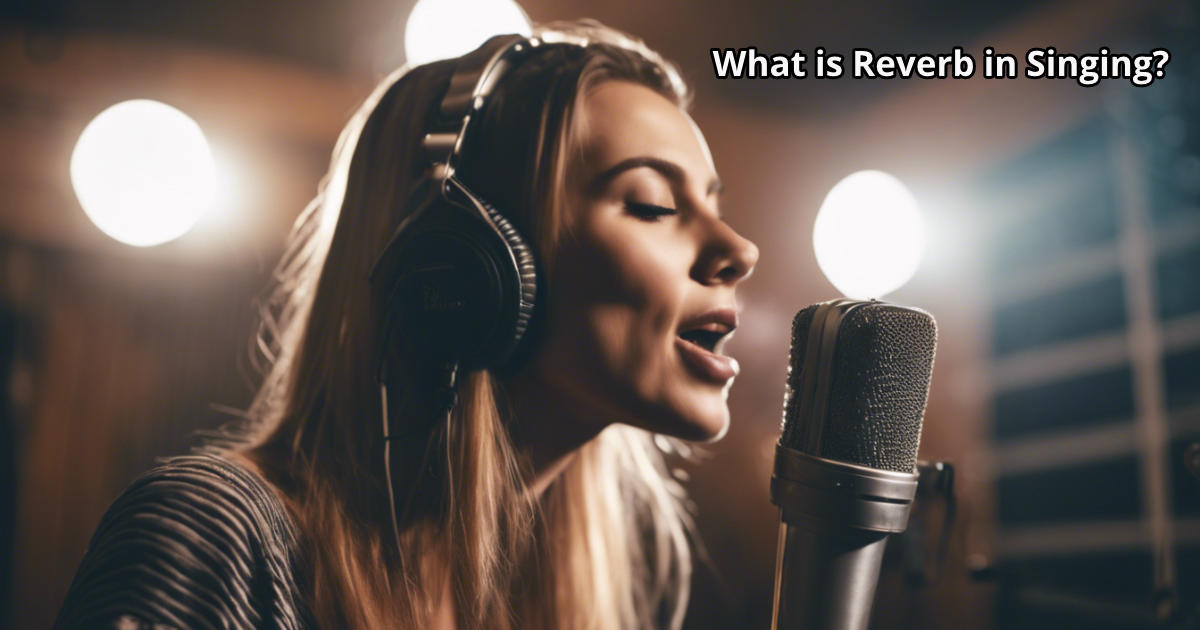Estimated reading time: 9 minutes
Ever wonder why your favorite songs have that magical touch that makes them echo in your mind long after they’ve ended? That, my friends, is the magic of reverb in singing. It’s like the secret sauce that can turn a good vocal performance into a breathtaking one. But what exactly is it, and why does it matter so much in music, especially in singing?
Table of contents
- Understanding Reverb: Dry Vocals vs Vocal Reverb
- Why does Reverb matter in Singing?
- The Science Behind Reverb: Explaining Dry Signal and Vocal Frequencies
- Types of Reverb: Plate, Hall, Spring, Chamber, and Gated Reverb
- Decoding the Magic: The Role of Pre-Delay, Pass Filter, and Smooth Decay in Reverb
- How Reverb Affects Vocal Sound: An Examination of Reverb Tails and Vocal Effects
- The Impact of Reverb Settings on Vocal Tracks
- Reverb and Other Effects: Comparing Reverb vs Delay
- Auxiliary Track and Compressor Settings in Reverb
- Exploring Reverb in Different Contexts: Acapella vocals and Guitar Amplifiers
- Overview of Artificial Reverbs: How They Impact Concert Hall and Plate Reverb
- The Best Reverb Plugins for Singers
- Vocal Reverb Explained in a Video
- Conclusion: Embrace the Magic of Reverb in Singing
- FAQs
Understanding Reverb: Dry Vocals vs Vocal Reverb
Imagine singing in your bathroom and then in a large cathedral. Notice the difference? That’s reverb for you. In simple terms, dry vocals are what you get when the sound is unaltered, raw, right from the source. Add reverb, and it’s like your voice is spreading out, filling the space, creating an ambiance. It’s not just about being loud; it’s about adding depth, texture, and emotion to the voice.
| Aspect | Dry Vocals | Vocal Reverb |
|---|---|---|
| Sound | Unaltered, raw, direct from the source | Altered, with added depth and ambiance |
| Perception | Intimate, immediate | Spacious, immersive |
| Ambiance | Minimal or no sense of space | Fills the space, creates atmosphere |
| Texture | Clear and straightforward | Adds richness and complexity |
| Emotional Impact | Direct and upfront | Enhances emotion and mood |
| Spatial Presence | Minimal sense of environment | Gives a sense of being in a specific acoustic space |
Why does Reverb matter in Singing?
Reverb matters because it adds life to a song. It can make vocals feel closer or farther away, help them blend with the music, or stand out. It’s essential for creating the mood or the vibe of the track. Whether it’s making a ballad more soulful or a rock song more powerful, reverb plays a key role in the emotional impact of a song.

The Science Behind Reverb: Explaining Dry Signal and Vocal Frequencies
The science of reverb is fascinating. When we sing, our vocal cords create sound waves that travel through the air. In a “dry” setting, these waves go directly to the microphone. But in a real-world setting, they bounce off surfaces, creating multiple echoes that mix with the original sound. This mixture is what we perceive as reverb. It’s all about how sound waves interact with the environment and the frequencies of the vocals.
| Concept | Dry Signal | Vocal Frequencies with Reverb |
|---|---|---|
| Signal Transmission | Direct sound wave from the source | Sound waves reflect off surfaces, creating multiple echoes |
| Frequency Interaction | Original frequencies remain unchanged | Frequencies interact with room surfaces, altering their characteristics |
| Echoes and Reflections | Minimal echoes or reflections | Multiple reflections create a complex, reverberant sound |
| Perception of Space | Limited spatial perception | Enhanced spatial perception, with a sense of depth and environment |
| Impact on Sound Quality | Clear and immediate | Adds richness and complexity to the sound |
Types of Reverb: Plate, Hall, Spring, Chamber, and Gated Reverb
Reverb comes in many flavors, each with its unique character. Plate reverb gives a bright, shimmering quality perfect for vocals. Hall reverb replicates the expansive sound of singing in a large hall, giving a sense of grandeur. Spring reverb, with its distinctive twang, is great for adding a vintage vibe. Chamber reverb offers a warmer, more natural sound. Gated reverb, which abruptly cuts off the reverb tail, can add a dramatic effect.
| Reverb Type | Description | Characteristics |
|---|---|---|
| Plate Reverb | Uses a vibrating metal plate to create reverberations | Bright, smooth, and shimmering sound |
| Hall Reverb | Simulates the spaciousness of a large concert hall | Expansive, natural decay, ideal for vocals |
| Spring Reverb | Utilizes a coiled spring to generate reverberations | Twangy, vintage sound with a quick decay |
| Chamber Reverb | Produced in an acoustic chamber or room | Warm, natural, and intimate |
| Gated Reverb | Reverb signal is abruptly cut off using a noise gate | Creates a short, dense reverb with a dramatic effect |
Decoding the Magic: The Role of Pre-Delay, Pass Filter, and Smooth Decay in Reverb
The magic of reverb is in the details. Pre-delay sets the time before the reverb effect kicks in, allowing the original sound to stand out before it’s enveloped in reverb. A pass filter helps shape the tone of the reverb, making it brighter or darker. Smooth decay ensures the reverb fades out naturally, without abrupt stops, making the effect more realistic and pleasing to the ear.
| Reverb Element | Description | Function |
|---|---|---|
| Pre-Delay | Time delay before reverb onset | Allows original sound to be heard before reverb effect |
| High-Pass Filter | Filters out low frequencies in the reverb signal | Shapes the tone of the reverb (brighter or darker) |
| Smooth Decay | Gradual fading of reverb tail | Ensures natural and pleasing decay of the reverb effect |

How Reverb Affects Vocal Sound: An Examination of Reverb Tails and Vocal Effects
Reverb tails, the lingering sound after the initial note is sung, play a huge role in the character of the reverb. They can make a vocal track feel lush and spacious or tight and intimate, depending on their length and texture. Different vocal effects, like doubling or harmonizing, can also be enhanced with the right reverb, adding richness and complexity to the sound.
| Aspect | Description |
|---|---|
| Reverb Tails | Lingering sound after the initial vocal note |
| – Length of reverb tails affects perceived space | |
| – Texture and decay impact overall ambiance | |
| Vocal Effects | Doubling or harmonizing effects enhanced by reverb |
| – Reverb adds depth and richness to vocal layers | |
| – Enhances vocal texture and complexity |
The Impact of Reverb Settings on Vocal Tracks
Getting the reverb settings right can make or break a vocal track. Too much reverb can drown the vocals, making them sound muddy. Too little, and the track might feel dry and lifeless. It’s about finding the perfect balance, considering the song’s mood, the genre, and the vocalist’s style.
| Reverb Setting | Impact on Vocal Tracks |
|---|---|
| Reverb Amount | – Too much: Drowns vocals, sounds muddy |
| – Too little: Vocals may sound dry and lacking depth | |
| Decay Time | – Short decay: Tight and intimate feel |
| – Long decay: Creates a spacious, lush sound | |
| Pre-Delay | – Short pre-delay: Reverb effect starts quickly |
| – Long pre-delay: Allows vocals to stand out before reverb | |
| EQ Adjustments | – High-frequency boost: Adds brightness to reverb |
| – Low-frequency cut: Reduces muddiness in lower range |
Reverb and Other Effects: Comparing Reverb vs Delay
While reverb and delay both add space and depth to vocals, they do it differently. Delay repeats the sound at intervals, creating an echo effect. It’s great for adding rhythm or a sense of movement to the vocals. Reverb, on the other hand, creates a continuous wash of sound, blending the echoes seamlessly. Both can be powerful tools in shaping the vocal sound.

Auxiliary Track and Compressor Settings in Reverb
Using an auxiliary track for reverb can give you more control over the effect. It allows you to adjust the amount of reverb independently from the original vocal track. Compressor settings can also play a crucial role, especially in ensuring that the reverb doesn’t overpower the dynamics of the vocals. It’s all about balance and blending the effects smoothly.
| Setting | Description |
|---|---|
| Auxiliary Track | – Allows separate control of reverb effect |
| – Adjusts reverb amount independently of vocal track | |
| Compressor | – Controls dynamic range of vocal and reverb combined |
| – Prevents reverb from overpowering vocal dynamics |
Exploring Reverb in Different Contexts: Acapella vocals and Guitar Amplifiers
Reverb isn’t just for solo acapella vocals; it can transform acapella performances, adding a sense of unity and space to the harmonies. It’s also a key element in the sound of guitar amplifiers, where it can add depth and ambiance to the guitar tone, from subtle warmth to cavernous echoes.
| Context | Description |
|---|---|
| Acapella Vocals | – Adds sense of space and cohesion to vocal harmonies |
| – Enhances vocal blend and unity in acapella performances | |
| Guitar Amplifiers | – Adds depth and ambiance to guitar tone |
| – Ranges from subtle warmth to cavernous echoes |
Overview of Artificial Reverbs: How They Impact Concert Hall and Plate Reverb
With advances in technology, artificial reverbs can convincingly replicate the sound of singing in different environments, from concert halls to plate reverbs. These digital recreations allow singers and producers to experiment with a wide range of sounds, regardless of the physical space they’re in.
| Artificial Reverb | Impact on Concert Hall Effect | Impact on Plate Reverb Effect |
|---|---|---|
| Simulation Quality | Replicates the spaciousness and grandeur of a concert hall | Emulates the bright and shimmering quality of a plate reverb |
| Customizability | Allows adjustment of room size, decay time, and reflections | Offers control over metallic resonance and tonal character |
| Realism | Creates a realistic sense of acoustic environment | Provides a classic, vintage reverb sound experience |
The Best Reverb Plugins for Singers
The market is full of reverb plugins, each offering something unique. Some of the best ones provide a wide range of reverb types, customizable settings, and realistic sound quality. Whether you’re looking for something specific like a hall reverb or a versatile plugin that can handle it all, there’s likely a perfect match out there for your needs.
Vocal Reverb Explained in a Video
Conclusion: Embrace the Magic of Reverb in Singing
Reverb is more than just an effect; it’s a way to bring emotion, depth, and texture to vocal performances. Whether you’re a singer, a producer, or just a music enthusiast, understanding and experimenting with reverb can open up new possibilities in the way you experience and create music. So go ahead, embrace the magic of reverb in singing, and let it take your vocal tracks to new heights.
Related Posts
- What is a Reese Bass? Unraveling the Mystery
- What is Plate Reverb? The Simple Guide You’ve Been Waiting For
FAQs
Reverb in singing refers to the effect of sound reflections bouncing off surfaces in a space, adding depth and ambiance to vocals. It creates a sense of space around the voice, enhancing the overall texture and emotional impact of the performance.
Reverb is crucial in music because it adds dimension and character to vocals, making them sound more lively and engaging. It helps vocals blend with the music or stand out, setting the mood and enhancing the emotional expression of a song.
Common types of reverb include Plate, Hall, Spring, Chamber, and Gated reverb. Each type has its unique sonic characteristics, ranging from bright and shimmering to warm and natural. The choice of reverb type can greatly influence the mood and style of a vocal performance.
Reverb affects vocal tracks by adding texture, depth, and spatial presence. It can make vocals sound closer or farther away, depending on the reverb settings. The length and character of reverb tails contribute to the overall atmosphere and feel of the vocal recording.
Use reverb judiciously to enhance vocals without overpowering them. Experiment with different reverb types and settings to match the genre and mood of the song. Consider factors like pre-delay, decay time, and EQ adjustments to tailor the reverb effect to your specific vocal needs.
